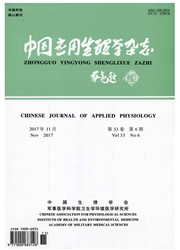

 中文摘要:
中文摘要:
目的:分析海洛因诱导条件性位置偏爱(CPP)大鼠的伏隔核(NAc)脑电活动在海洛因依赖不同时期的变化特征,探讨其在药物依赖形成过程中的作用。方法:通过立体定位向大鼠NAc埋藏电极,建立海洛因依赖大鼠模型,用无线遥测方法分别记录海洛因给药前、给药后即刻及戒断状态3个时期内大鼠NAc神经元放电活动,分析NAc神经元脑电活动的频率(0.5 Hz-30 Hz)分布及波幅。结果:CPP系统建立海洛因依赖模型有效,大鼠戒断症状明显。海洛因给药5-10 d,大鼠陆续出现白箱CPP,戒断2 d时戒断症状达高峰。各时期内大鼠NAc脑电活动δ波比例皆最高,α2波比例最低,不同频段脑电的分布梯度相似。与给药前和戒断期相比,给药后即刻状态NAc低频放电(δ波)比例明显升高(P〈0.01),高频放电(β波)比例明显降低(P〈0.01);戒断期α1波比例明显小于其它各期(P〈0.01)。与给药前相比,给药后即刻和戒断期NAc脑电活动平均波幅均显著增大(P〈0.01),但戒断期的平均波幅比给药后即刻期的明显降低(P〈0.01)。结论:海洛因依赖不同时期内大鼠NAc的脑电活动出现明显变化,提示NAc神经元活动可能参与药物依赖的调节。
 英文摘要:
英文摘要:
Objective: To analyze the electrical activity property changes in nucleus aceumhens (NAt) of heroin-induced conditioned place preference (CPP) rats during different stages of heroin dependence and to explore NAe' s roles in the formation of drug dependence. Methods: Recording electrodes were bilaterally embedded into the NAes of rats with the aid of stereotaxic apparatus, followed by establishment of heroin-dependent rat model. The NAc electrical activity during 3 different stages of heroin dependence, including heroin pre-exposure, immediate post-exposure and heroin withdrawal, were respectively recorded using EEG wireless telemetry techniques. The frequency distribution (ranging from 0.5 to 30 Hz) and the amplitude of NAe electrical activity were analyzed and measured. Results: Heroin-dependent rat models were successfully established and their withdrawal symptoms were evident. All rats showed a conditioned place preference (CPP) for the white box after 5- 10 days of herein-exposure, and displayed a maximum withdrawal symptoms on 2d after heroin- withdrawal. During all statges of heroin-dependence, the NAe electrical activity contained the highest proportion of δ rhythm and the lowest proportion of α2 rhythm. The discharge frequence band was similar across different stages. There was a significantly increased ratio of low-frequency discharges (8 rhythm) and decreased ratio of high-frequency discharges (β rhythm) in NAc of rats during the immediate post- heroin exposure stage when compared with that during pre-exposure and heroin withdrawal stages. During the withdrawal stage, the ratio of α1 rhythm was significantly lower than during pre- and post-heroin exposure stages (P 〈 0.01). Further, the mean discharge amplitude in NAcs during immediate post-exposrure and with- drawal stages was significantly increased relative to pre-exposure stage. However, the mean discharge amplitude during heroin withdrawal stage was significantly lower than during immediate post-exposure st
 同期刊论文项目
同期刊论文项目
 同项目期刊论文
同项目期刊论文
 Decreased contrast sensitivity of visual cortical cells to visual stimuli accompanies a reduction of
Decreased contrast sensitivity of visual cortical cells to visual stimuli accompanies a reduction of 期刊信息
期刊信息
